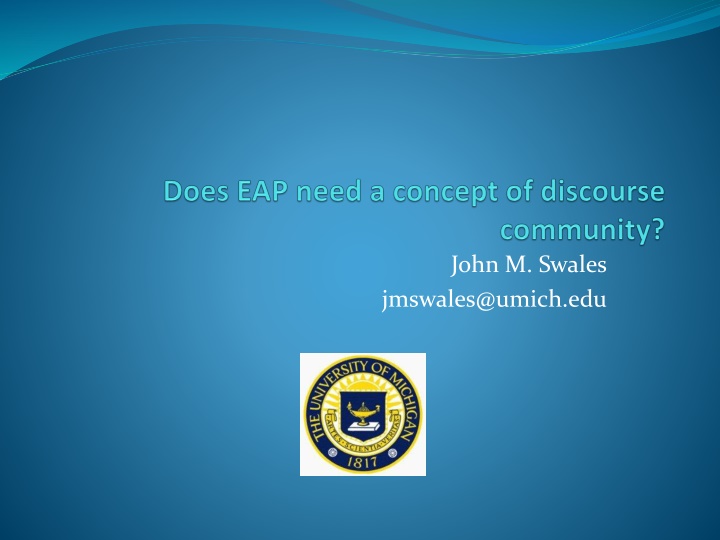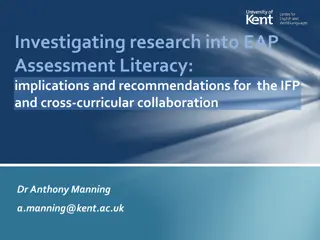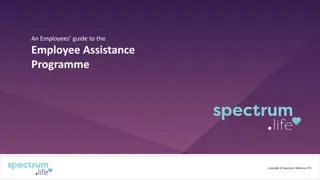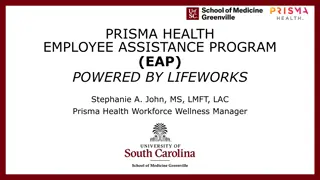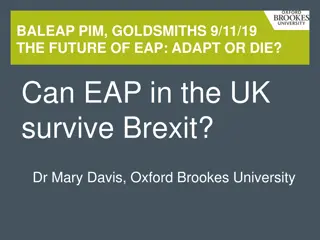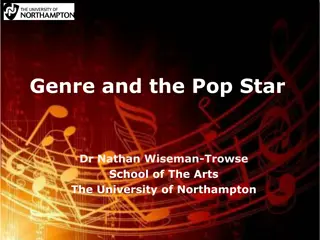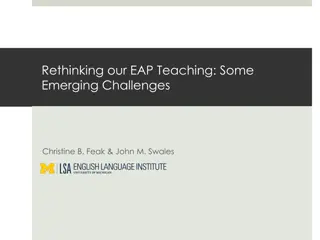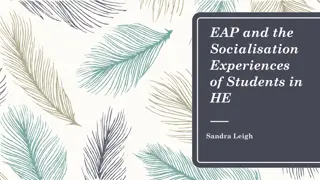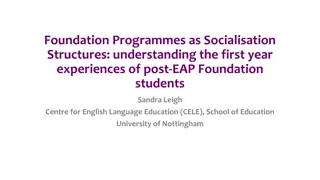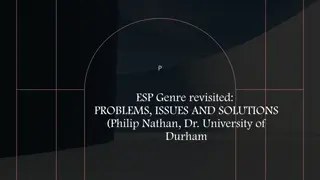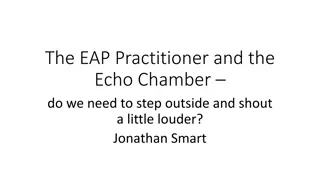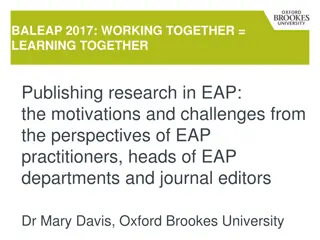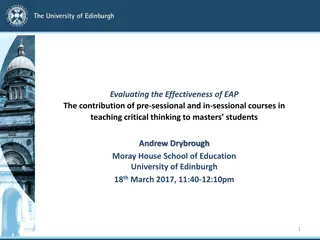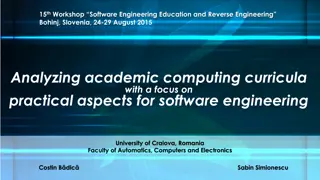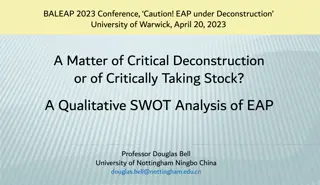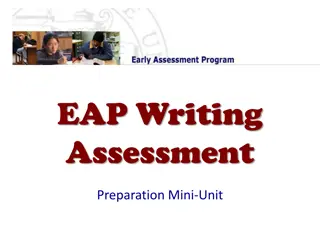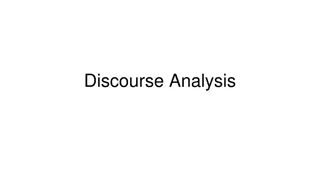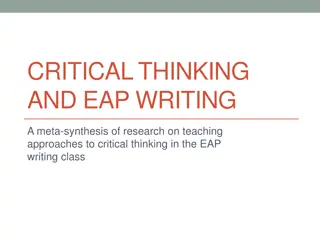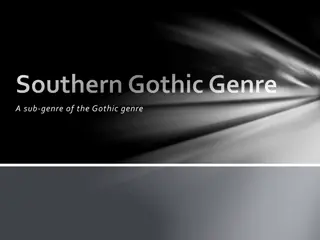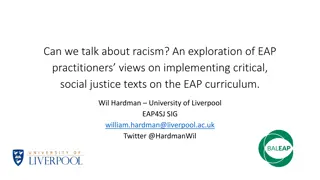Genre, Task, and Discourse Communities in EAP Curricula
John Flowerdew's argument on the powerful triad of concepts shaping EAP curricula delves into the complexities of genre, task, and discourse community interactions. The nuances of comparing discourse communities to other social constructs are scrutinized, raising questions on their nature, impact, and evolution. Swales' defining characteristics of discourse communities provide valuable insights into their functioning and significance within academic settings.
Download Presentation

Please find below an Image/Link to download the presentation.
The content on the website is provided AS IS for your information and personal use only. It may not be sold, licensed, or shared on other websites without obtaining consent from the author.If you encounter any issues during the download, it is possible that the publisher has removed the file from their server.
You are allowed to download the files provided on this website for personal or commercial use, subject to the condition that they are used lawfully. All files are the property of their respective owners.
The content on the website is provided AS IS for your information and personal use only. It may not be sold, licensed, or shared on other websites without obtaining consent from the author.
E N D
Presentation Transcript
John M. Swales jmswales@umich.edu
Recently, John Flowerdew has argued that: Genre Task Discourse community form a powerful triad of concepts that undergird EAPcurricula.
Not much doubt about genre and task Especially if we remember to see genre realisations as contextually bound performances rather than reproductions of types of text Especially if we conceive of tasks as ranging from the nuts and bolts of language acquisition to rhetorical consciousness raising. And remember Michael Swan s old complaint about EAP. But discourse community (DC)?
Perhaps a troubled concept A) Is it the same as community of practice (Lave & Wenger) or disciplinary community, or communicative community (Gunnarsson)? B) Are speech and discourse communities so separate; (A homogenous sociolinguistic assemblage) v. a heterogenoussociorhetorical assemblage)?
Of course, you say, it is not as simple as that The effects of national media, globalization, international trade, cell phones, etc Place and occupation intersect: university towns (Cambridge, Heidelberg) sporting towns (Saratoga, St. Andrews) government towns (Washington, Ottawa) religious towns (Assisi, Mecca) fishing towns, mining towns, gaming towns, etc Family traditions, caste restrictions, class preferences
C) What is its standing? A robust social construct? A convenient covering metaphor? A deluding utopian fiction? (Harris) D) Why has it become so ossified?
Google The concept of discourse community Wikepedia. Swales presents six defining characteristics: A discourse community: 1) has a broadly agreed set of common public goals 2) has mechanisms of intercommunication among its members 3) uses its participatory mechanisms to provide information and feedback 4) Utilizes and possesses one or more genres in the communicative furtherance of its aims. 5) in addition to owning genres, it has acquired some specific lexis. 6) has a threshold level of members with a suitable degree of relevant content and discoursal expertise.
What else does Google pull together about DCs? Extracts from published work (Wardle & Downs; Eric Borg; Swales 1998; Beaufort; Ann Johns, etc) Established Websites (Researchomatic; NCTE Issue Brief on Discourse Communities, etc Blog Posts (instructor explanations. Students: about half summarize and apply the six criteria to some experience they have had. (Wardle & Downs, Writing about Writing) (very few demurrals; One (Jordan Rosa: Questions I still have: Are these the only characteristics of a discourse community, or are there more? How many more? )
What do I feel about this? (Vainglorious) gratification, but a sense of dismay at the inertia. Acceptance and application of something that was written in the late 1980s: before today s undergrads were born, before globalization, and before social media.
Heather Waynes slide show Using the 6 criteria, are these discourse communities? 1) A soccer team 2) A sorority/fraternity 3) UCF (University of Central Florida) 4) Publix employees (a chain of supermarkets in the south) 5) The Hong Kong Study Circle 6) Republican voters 7) College Democrats at UCF 8) Composition scholars 9) Occupants of Nike dorms (residence halls) 10) Our class
No more Utopian fantasy; Untuning Ulysses string without total discord Heronstein Smith s observation that too many scholars miss and obscure each individual s membership in multiple communities, communities that require many social roles, and subsequently a collage of allegiances, beliefs and sets of motives . A Professor of Linguistics and Director of the ELI
Outsider and insider perspectives on communities To an outsider, a Ling. Dept = people who share a like- minded interest in language. To an insider, a phonologist is very different to a phonetician, and so on. To an insider, a world of difference between those interested in language and mind, those interested in language & society.
The Burkean Parlor & Entrances and Exits The 6 criteria piece was written late 1980s. In a changed world, more attention in entries, re-entries, exits. Lave & Wenger s community of practice deals with this aspect Qualification/admission/entry Apprenticeship/probation/acculturation membership seniority old-fartage
Discourse community reconsiderd 1. A DC has a broadly agreed set of goals 1a. A DC has a potentially discoverable set of goals. These may be publicly and explicitly formulated (as in mission statements ), and/or may be generally or partially recognized by its members; they may be consensual; or they may be separate but contiguous (Old Guard and Young Turks; academic researchers and practitioners, as in the just- holding-together American Psychological Association). (A darker world, not excluding Al-Q aida, cabals, industry pressure groups etc)
2. A DC has mechanisms of intercommunication among its members 2a. Little change, but for new digital channels, interactive websites, blogs, Twitter, texting etc. (So subscribers to The Economist are not members of a discourse community.)
3. Uses it participatory mechanisms to provide information and feedback Always sadly incomplete. 3a. Uses its participatory mechanisms to manage the operations of the DC and to promote (usually) change, growth and development or to orchestrate (rarely) retrenchment and demise. As Jim Martin said Genres are how things get done when words are used to accomplish them .
4. A DC utilizes and hence possesses one or more genres in the communicative furtherance of its aims. (Possesses?) 4a. A DC utilizes an evolving selection of genres in the furtherance of its sets of goals and as a means of instantiating its participatory mechanisms. These sets of genres are often particularized. (The genres are performed, re-performed and refined, but rarely owned (i.e. uniquely theirs.). (The Friday afternoon get-together: Happy Hour; Birthday Celebrations; the 4 p.m. Departmental seminar )
5. In addition to owning genres, it has acquired some specific lexis. 5a. A DC has acquired and continues to refine DC-specific terminology. Classically, these consist of abbreviations and shorthands of all kinds, not excluding things like The tuna sandwich in the corner wants a refill ; the meatloaf is 86- ed . (In the older ELI; A new student may be described as She looks like a 73 across the board . In a hospital, Code 236 on floor 6.
6. A DC has a threshold of members with a suitable degree of relevant content and discoursal expertise. 6a. A DC has an explicit or implicit hierarchy and/or structure which, inter alia, manages the processes of entry into and advancement within the discourse community.
Two additionsthe first 7. A DC develops a sense of silential relations (Becker) whereby there is a sense of things that do not need to be said or do not need to be spelled out. Members of a Bridge Club The Vauxhall Dining Centre
The second 8. A DC develops horizons of expectation, defined rhythms of activity, a sense of its history, and value systems for what is good and less good work. How long is it before stuff goes out of date? What rotas and rosters have evolved? What is considered important?
After Porter, two types of DC Local DCs (residential, vocational, occupational) In my own unit, I know the building hours technical help supplies the photocopier
Focal communities: Associations (regional, national, international: professional, recreational.) BALEAP, TESOL, GERAS. (Conferences, PIMs, SIGs, Websites, Email groups, Committees, Elections, Officers)
Living in a folocal world Academics are expected to be active in their local DCs and in their focal ones. Often a tension between admin & teaching in your home institution and involvement in research, scholarship, publication, presentation and service to the profession . Double membership: local responsibilities v. wider recognition.
So, does EAP need a concept of discourse community? The value of the concept seems variable, depending on the constituency we are attempting to serve. At one polarity, doctoral students and post-docs (established norms of cognitive and communicative behaviours) At the other, presessional students preparing for IELTS, no heuristic value
At the doctoral level: Hopefully embedded in the host unit Hopefully given useful membership roles Hopefully moving into the focal community (Powerpoint slides in Art History) (Tony Becher s story)
Students on foundation courses, hopping from one disciplinary island to the other, need to gain a sense of disciplinary expectations rather than DC ones. ? Senior undergraduates & M.A students
Final Considerations Two Quotations The term discourse community is useful for describing a space that was unacknowledged before because we did not have a term for it. The term realigns the traditional unities writer, audience, text into a new configuration. What was largely scene before, unnoticed background, becomes foreground. (James Porter, 1992) Why has DC theory have such strange features: instant adoptability, resilience in the face of critique, resistance to calls for theoretical specification, the protean character of its fundamental assumptions as it migrates across theoretical and empirical traditions? (Paul Prior, 2003)
But is it a robust social construct? Probably not. A historian might say it doesn t account for social, economic or political forces that impact a DC. A sociologist might say it doesn t acknowledge the effects of broader social structures. An educationist might say it downplays acquisitional trajectories as well as the roles of individual agencies. An anthropologist might say it ignores important aspects of cultural history
If it is not robust, does it matter? Probably not. Like Porter, it can be argued if your focus is on rhetorical principles of organization, on discoursal expectations, and on telling linguistics tokens, it provides insight into what at first sight might seem standard, ordinary and predictable. Even if, DC descriptions are blurred snapshots, always imperfectly pinning down conventions and topoi that are in flux (Laura Wilder, 2012)
Thank You jmswales@umich.edu
